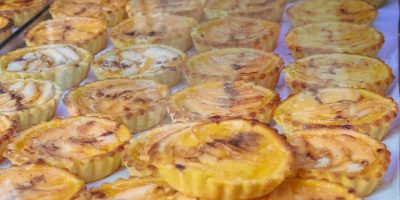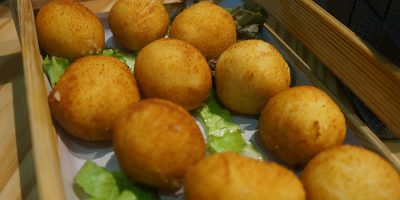If you plan your Camino de Santiago trip, you’ll likely visit Galicia soon. One of the best parts about travelling is trying all the local dishes, especially if you’re a foodie. We’ve picked the ten most delicious Galician dishes you must try on your Camino adventure. These traditional recipes reflect the heart of Galician culture and are made with fresh, local ingredients that tell a story in every bite.
1. Octopus
The ultimate Galician traditional dish. You will find it referred to as ‘pulpo á feira’ (in Galician), ‘pulpo a la gallega’ (in Spanish) or simply ‘pulpo’. Cooking octopus is an art in Galicia, boiled to a perfect point and served with paprika, salt, and olive oil.
It can’t be too hard or mushy; it must be perfect. Don’t be fooled by the dish’s simplicity: a great ‘pulpeiro’ (someone specialising in cooking octopus) is not easy to come by!
If you are walking the Camino Frances via Melide, you should stop at A Garnacha for a taste of delicious octopus. Many pilgrims have recommended it to us.

2. Padrón Peppers
Padrón peppers are a true Galician treat, especially when enjoyed in their peak season—summer. These small green peppers are traditionally fried in olive oil and finished with a sprinkle of rock salt. But be warned—they’re famously unpredictable. As the popular Galician saying goes, “Pementos de Padrón; uns pican e outros non,” meaning “some are hot, and some are not.”
Most are mild and sweet, but every now and then, one packs a fiery punch, making them a bit like a culinary game of chance. People often guess which ones will be spicy—some say the smaller ones, others say the ones with a sharper tip—but no one really knows. That little mystery is what makes eating them so much fun.

3. Empanada
Empanadas are a much-loved staple in Galician cuisine, and locals are known to enjoy them with just about any filling. These savoury pastries come in different shapes and sizes, but seafood and fish are the traditional favourites. Common fillings include cod (bacalao or bacallao), mussels (mejillones or mexillóns), and tuna (bonito). The taste of an empanada can vary depending on the baker, the texture of the pastry, and the quality of the ingredients inside—but one thing is certain: they’re always satisfying and full of flavour.
4. Caldo Galego
Vegetarians, take note—Caldo galego (Galician broth) may appear to be a simple, vegetable-based soup with cabbage, leafy greens, and white beans, but it’s often enriched with pork fat and sometimes pieces of pork meat for extra flavour. This hearty, comforting dish is a winter favourite across Galicia, traditionally made in family kitchens and passed down through generations. It’s a true taste of home for many locals.

5. Squid: all shapes and sizes!
Crispy squid rings—known as calamares or luras in Galician—and tender baby squid (chipirones) are lightly coated in batter and fried to golden perfection. A squeeze of fresh lemon juice is all they need. Whether served hot or enjoyed cold, they make for one of the tastiest and most popular Galician snacks.
6. Queixo de Tetilla
Galician cheese might be a hidden gem for many cheese lovers. Made mostly from cow’s milk, it tends to be soft, creamy, and only lightly matured. It’s often served as a dessert, paired beautifully with a slice of sweet quince jelly.
One of the most iconic cheeses in Galicia is queixo de tetilla, named for its distinctive pointed shape—‘tetilla’ meaning ‘little breast’ in Galician. As you journey along the Camino Francés towards Santiago, you’ll pass through Arzúa, a town famous for producing this beloved cheese. It’s a must-try for anyone with a taste for local dairy delights.

7. Shellfish
Galicia is often hailed as the seafood capital of Spain—and with good reason. From clams, mussels, and cockles to lobsters, prawns, crabs, and the famously prized gooseneck barnacles, the variety is remarkable. You’ll also find top-quality fish like tuna from Burela, hake, monkfish, and sardines. The seafood here is not only fresh and seasonal but also of outstanding quality, making every meal a special experience. A visit to the bustling food market in Santiago will give you a real taste of what Galicia has to offer. And if you’re spending time along the coast, prepare to be spoilt for choice.

8. Galician Beef
Another Galician favourite that’s loved across Spain is Ternera Gallega, or Galician beef. It’s a great option if seafood isn’t your thing, offering tender, high-quality meat with rich flavour. Raised in the lush green pastures of Galicia, this beef is known for its excellent texture and is often grilled or slow-cooked in traditional stews.
9. Tarta de Santiago
The traditional almond cake marked with the cross of Santiago is a beloved sweet treat, perfect with a coffee or as a light dessert after a meal. While many towns across Galicia have their own versions of almond tarts, each one adds its unique twist to the recipe. The Tarta de Santiago remains the most iconic—simple, rich, and full of flavour. If you’d like to try making it yourself, take a look at our easy Tarta de Santiago recipe.

10. Flan
Crème caramel, or flan, is a favourite dessert throughout Galicia. In autumn, many restaurants and bars offer a special twist on this classic—flan made with chestnuts. If you get the chance, don’t miss trying it; it’s wonderfully rich and pairs beautifully with a dollop of whipped cream. For a perfect nightcap to aid digestion, why not enjoy a small ‘chupito’ of herb or coffee liqueur? It’s a popular way to end a meal in the region.
Food lovers visiting Santiago de Compostela shouldn’t miss the Mercado de Abastos. After the Santiago cathedral, it’s one of the city’s top attractions, bursting with fresh, local produce and a lively atmosphere that captures the spirit of Galician cuisine.
Before your next trip, be sure to download our Camino Food eBook. It’s the perfect guide if you want to discover everything about the delicious food waiting for you along the Camino routes. If you’d like to learn more about the Camino de Santiago or need help booking your trip, feel free to get in touch with us.
Maria shares her insights on the 10 most delicious Galician dishes below.








Thank you for the thoughtful article regarding Galician cusine. If I may ask, do you recall a Galician salad that was primarily black-eyed peas? My grandmother on my mother’s side was first-generation Cuban as her parents migrated to Cuba from A Coruña. Thank you in advance for any insight you can provide to my request.